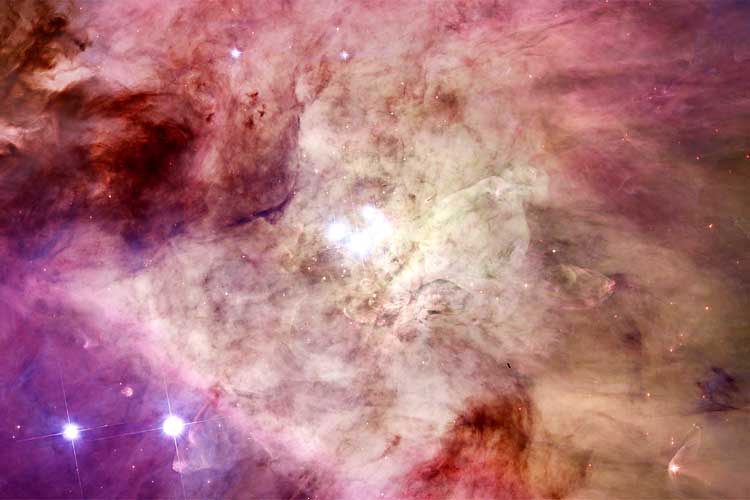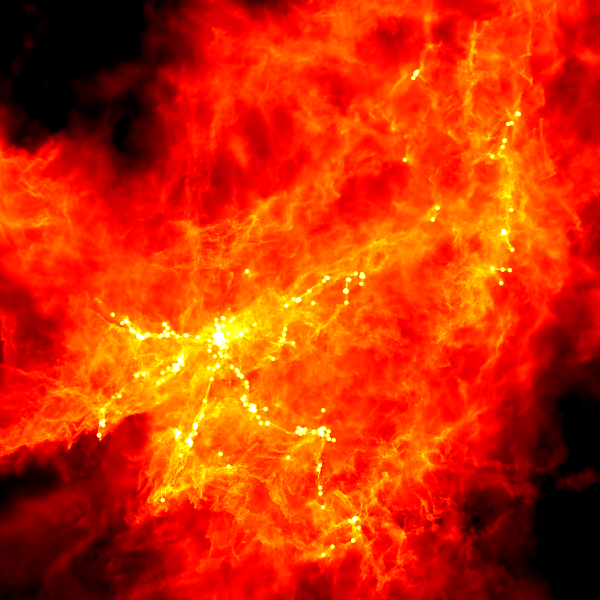Molecular clouds
Practically all star formation is thought to occur in vast complexes of
molecular hydrogen gas, known as giant molecular clouds (or just GMCs),
containing anywhere from a thousand to about 10 million times the mass of the
Sun.
 They also cover a large region and can have diameters in the range of
1-100 parsecs (a parsec is roughly 3 light years or 300,000 times the distance
between the earth and the Sun). A classic example of such a region can be found in
the constellation of Orion, in which one finds the Orion Molecular Cloud (shown in
the image here), containing
several distinct regions and evidence of both recent and ongoing star formation.
The internal evolution of these clouds is controlled by many physical processes
, such as gravity, turbulence, magnetic fields,
radiation, heating and cooling processes, chemistry and the formation of dust,
to name but a few.
The complexity of their formation, evolution and dispersal has made GMCs a key
subject for study in astromony, and the study of star formation requires a
good understanding of their properties.
They also cover a large region and can have diameters in the range of
1-100 parsecs (a parsec is roughly 3 light years or 300,000 times the distance
between the earth and the Sun). A classic example of such a region can be found in
the constellation of Orion, in which one finds the Orion Molecular Cloud (shown in
the image here), containing
several distinct regions and evidence of both recent and ongoing star formation.
The internal evolution of these clouds is controlled by many physical processes
, such as gravity, turbulence, magnetic fields,
radiation, heating and cooling processes, chemistry and the formation of dust,
to name but a few.
The complexity of their formation, evolution and dispersal has made GMCs a key
subject for study in astromony, and the study of star formation requires a
good understanding of their properties.
GMC formation and evolution timescales
The lifetime of a GMC is an important parameter in the study of star formation. The length of time between a cloud's formation and dispersal sets the whole time available for the star formation process. Different theories of how stars form predict different timescales for the whole process. The lifetimes of GMCs are therefore crucial for determining which of the current theories, if any, can successfully describe the full star formation picture. At the moment however, the typical lifetimes of GMCs is still under debate, with observational estimates ranging from around 4 to 40 million years. An assoicated problem is how long it takes for the atomic gas which is present in the interstellar medium to be turned into the molecular hydrogen that we see in GMCs. If this can occur quickly, and recent evidence suggests it can ( Glover and Mac Low 2007a, 2007b) ,then GMCs might form very quickly, and star formation would then have the chance to occur quickly ( <10 Million years ).
To help solve this problem, we are studying star formation in GMCs, from the formation and accumulation of molecular hydrogen from the atomic interstellar gas, through to the formation and evolution of clusters. The formation mechanism we are currently modelling is that whereby large scale shocks compress the atomic gas to densities at which molecular hydrogen is possible. For the transition from atomic to molecular gas, we use the chemical model of Glover and Mac Low (see above for link). To model the gas, we use Smoothed Particle Hydrodynamics (SPH). We can then easily follow the formation and evolution of clusters by invoking 'sink particles' to represent stars. This setup allows us to investigate the timescale for the molecular cloud formation and the timescale for the formation of clusters within.
Cluster formation
 |
GMCs are capable of forming many stars, and the active sites of star formation in these clouds tend to consist of stellar groups, or clusters. These can have a wide range of members, with small clusters having only a few tens of stars, up to objects such as the Orion Nebula Cluster, which contains several thousand members. Is is also common for GMCs to form several such clusters of different sizes, and for these to occur at slighty different times in the cloud's evolution.
By performing numerical simulations of molecular clouds using SPH codes, we plan to study how the internal turbulent dynamics gives rise to the observed sizes, masses, and distributions of clusters in molecular clouds. This will include addressing how quickly a cluster can form under typical turbulent conditions, whether this relates to the mass of the cluster, and how the cluster 'feeds' from its surroundings. An example of one such simulation is shown in the figure on the right. The image shows a region with roughly 4pc on a side, and the mass contained in this region is roughly 10,000 solar masses. Several clusters of different sizes have formed along side each other. These simulations also form the base for more advanced calculations looking at feedback (see below).
